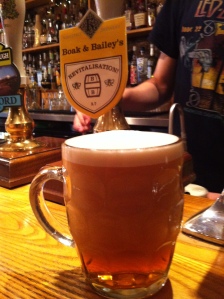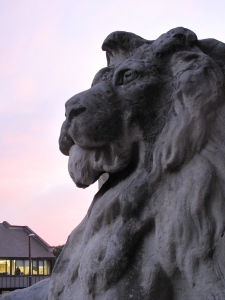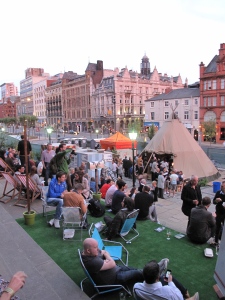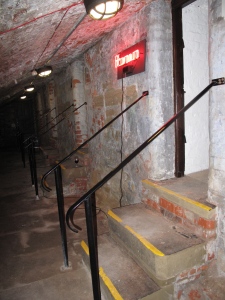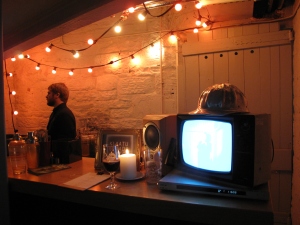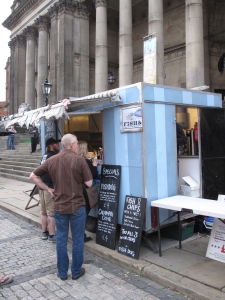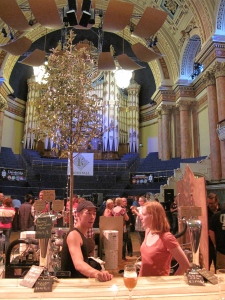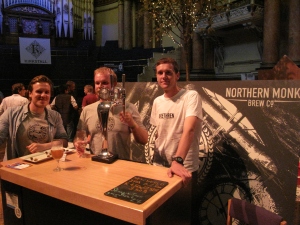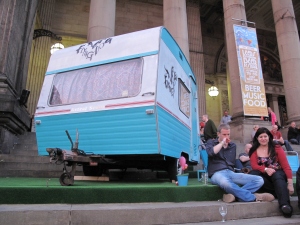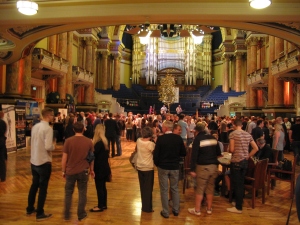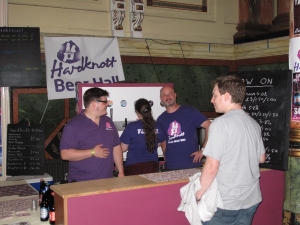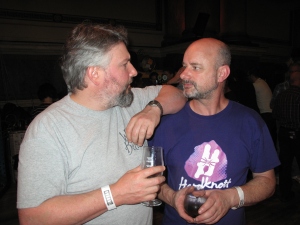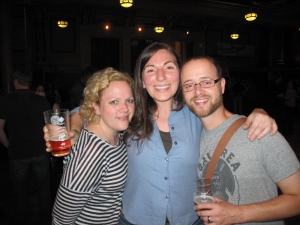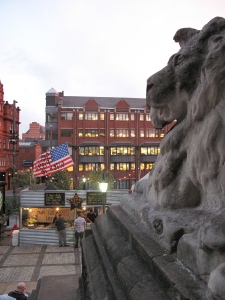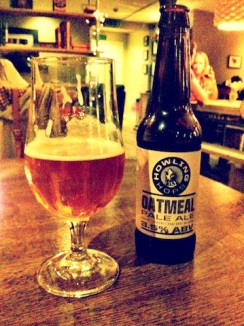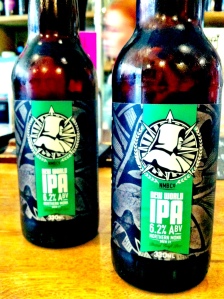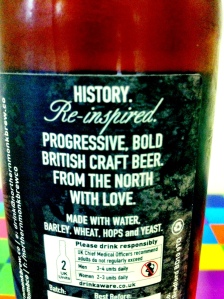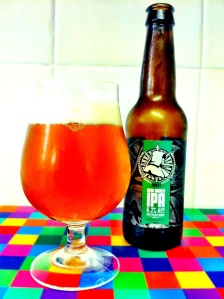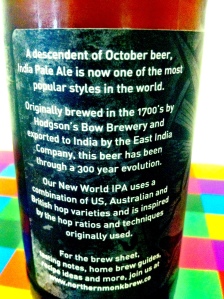Archive
Brew Britannia: The Strange Rebirth Of British Beer (Book Review)
In North Bar on Monday evening, when Ray Bailey signed my review copy of Brew Britannia: The Strange Rebirth Of British Beer, he told me to be honest in my opinion of it. In the end, there is no need to be anything other than candid: I haven’t devoured a book about beer so quickly and enjoyably since five years ago, when I read Pete Brown’s own social history of beer, Man Walks Into A Pub, sneaking off to read a couple of chapters in every lunch break.
Jessica Boak and Ray Bailey’s book traces the last fifty years of British beer, drawing together consumer organisations, brewers, writers, drinkers, pubs, restaurants, retailers, television personalities and politicians into a single narrative that is much more coherent and entertaining than anyone is entitled to expect. The results of extensive archive research and unique interviews are communicated in a clear and concise writing style, resulting in a text that moves at quite a pace through history, dropping in nuggets of amusing trivia along the way. I was grateful that they had waded through all those old newsletters so we don’t have to, but also regretted not having a pint with many of the interviewees.
Key actors, such as City gent and Society for the Preservation of Beers from the Wood founder Arthur Millard, ambitious Firkin entrepreneur David Bruce, restless brewing genius Brendan Dobbin and the canny, business-minded James Watt are sketched out in a delicate but wry manner that captures some aspect of their personality. The authors succeed in telling a story of fascinating and human characters, rather than what this might have been: a chronology of breweries, pubs and consumer organisations which started up, influenced the industry to one extent or another within a few years, then either collapsed or survived into varying degrees of irrelevance in a changed world, alongside more recent examples who have yet to do so.
Apart from the general sweep of the book, tracing the development of British beer from something which was enjoyed passively by those who drank it through to the real ale revival, winification and the more recent craft keg and diversity of obscure styles, there are some interesting recurring themes.
One such theme is the impact of class and politics in the beer movement. The gentleman piss artists of the Society for the Preservation of Beers from the Wood come together in the City of London, encouraged by the Financial Times’ beer journalism. The founders of the next generation consumer group, CAMRA, comprised journalists of a 1970s left-wing bent, leading to divisive conflicts over capitalist or campaigning activities. David Bruce, opening the Goose & Firkin in 1979, is determined to be a millionaire and achieves a profit of £2million on a sale of the chain in 1988, at the price of seeing it commoditised by the buyers.
The book should be appreciated by any reader with an interest in beer, regardless of prior knowledge. Those beer geeks who might feel that most writing on the subject, when it consists of more than just collections of tasting notes, tends to resurrect the same arguments, restate the same dubious history or descend into technical detail that means little to them, will be satisfied by the rigour of the research and the freshness of the writing. In particular I found that it corrected, tied together and placed in context disparate pieces of knowledge that I’d picked up from various sources, as well as including a great deal that was completely new to me, such the role of Jeremy Beadle in CAMRA or Oliver Peyton in the 1990s beer scene.
The book has a touching epilogue, revisiting the veterans of the SPBW, with the poignant final quote (which I won’t ruin for you) providing the apparent message of a book which otherwise maintains a tone of relative neutrality if not complete objectivity: that over 50 years successive generations have, often in very different ways, discovered what they believed to be “good beer” and valued it enough to do something about it.
Wolf In Sheep’s Clothing: Howling Hops Oatmeal Pale Ale (3.5% ABV)
“3.5%” on a bottle label can be a depressing thing for the drinker to see. If I know nothing else about a beer other than the ABV, if I see 3.5% I assume I’m in for something lacking in excitement. A mild. The most boring of brown bitters. A thin stout. Even where “New World hops” are advertised, you wonder if they wouldn’t rather be starring in something better, like a respected actor taking roles in artless films to pay a tax debt.
There’s a small number of good examples of New World-hopped low ABV beers, but most are primarily cask beers and don’t carry over well to bottles, if they even try. In particular they feel thin and dry, which can be fine, but not if you have a taste for big oily, sticky American IPAs. I’ve yet to try a passable 2.8% pale ale.
But sometimes you need something tasty in a bottle which will not challenge your sobriety. For that I recommend Howling Hops Oatmeal Pale Ale. I know, it sounds awful: 3.5% porridge pale. An albino oatmeal stout. From Hackney, no less. But instead, what you get is a crisp citrus-hopped beer with a remarkable amount of body, and if you didn’t know better you might place it somewhere north of 5.5%.
I assume it’s down to the oatmeal. If it is, perhaps oatmeal is the magic bullet for low ABV pale ales. If it isn’t – and remember that I know less about the science of brewing than most people reading this – forget all of the above. It’s still a really good little beer.
Brave New World: Northern Monk Brew Co New World IPA (6.2% ABV)
Craft beer has recently become, if not ubiquitous or always readily available, then certainly a trend of which people are increasingly aware. There are a number of examples of mainstream breweries and retailers, with varying success, attempting to capitalise on that popularity. There are also some new breweries that, on closer inspection, give the impression that they don’t quite “get” what is special about craft, but think that the concept might sell.
Against that context, and admitting that craft is an amorphous concept at the best of times, it might be easy to overlook genuinely interesting new breweries in all the noise. However, even before trying any of their beers, I was already reasonably confident that Northern Monk Brew Co would subscribe to my own concept of craft because of the involvement of David Bishop, familiar to beer blog readers and Tweeters as keen homebrewer and blogger @broadfordbrewer. You can read about David being approached by a prospective business partner and his progress with the brewery on his blog. You can also read an interview with co-founder Russell on This Beer Blog.
Their first beer is an IPA which was brewed in cuckoo/gypsy manner at Hambleton, which will be the provisional arrangement, along with some interesting collaborations, before an actual Northern Monk brewery is complete. Northern Monk had a launch party last week at The Sparrow in Bradford. I wasn’t able to attend, but did pick up a couple of bottles from Friends Of Ham in Leeds.
IPA is basically the core craft style and I’m happy to say that New World IPA is a great example of what it is intended to be. The first impression is excellent, with a lovely fresh aroma of pine and apricots. The taste is well-balanced, with a nice mix of fruity sweetness and a good lasting bitterness. It’s tasty but not so characterful that it wouldn’t seem “sessionable”, which could be a little dangerous for a 6.2% beer that doesn’t come across as that strong.
Regarding his short term ambitions, David has said:
So what do I want to achieve? I want to support my family and I want to do that by getting paid to do the thing that interests and excites me: brewing beer. How I go about doing that is also important to me and I need a game plan. Over to Stuart:
“The apparent conflict between idiosyncrasy and balance brings me to the question which I ask myself today. Am I trying to get a number one single or win the Turner Prize? Does there need to be a compromise?”
As a brewer just starting out I want to brew decent, tasty beer. I want the beer to be good enough to allow us to brew a second beer and so on. Don’t get me wrong, I want to do the best I can, but I’m not aspiring for a number one single. Not yet!
So now that we have that first beer, it’s gratifying that it tastes good, the branding looks good and the blurb is refreshingly free of utter marketing bollocks – the reality is that for a new brewery the branding is probably almost as important as the beer. The bottle isn’t covered in geeky detail about ingredients and IBUs but that’s all on the website.
On this evidence I’m very happy to say that Northern Monk’s first beer is more than good enough to ensure that people come back for the second. I very much hope that they do, not just because I like David and want him to make a living doing what he loves, but because, more selfishly, I want to drink more of his beer.
See another (better) review of New World IPA on Booze, Beats and Bites. Details of the first places that you might find Northern Monk beers in bottles and on keg are on their Twitter (@NMBCo) and Facebook pages.
Brooklyn Brewery Pop Up, 20-24 The Calls, Leeds City Centre
James Clay, importer of some of the best American, Belgian and German beers to the UK, have succeeded in an application for a licence to open a “pop up” Brooklyn Brewery bar in a warehouse on The Calls in central Leeds, despite police objections.
The bar will be in a currently empty warehouse at 20-24 The Calls, about 50 metres from BrewDog Leeds and 100 metres from The Stew & Oyster (Calls Landing). The licence application documents, which can be read here, show similar objections from the police as were made in the BrewDog licensing saga, to opening any new bar close to “an area which is an alcohol related crime hotspot, Call Lane” and the same “appreciation versus inebriation” arguments.
The Yorkshire Evening Post reports that representations were made to the sub-committee that the bar was to attract, “the well-behaved and “discerning” drinker, prepared to spend £7 or more on a pint of speciality beer“. A representative of the West Yorkshire Police stated that, “People with money still have the ability of causing trouble when inebriated.” Surely not.
The bar is stated to be temporary, although it is not clear for how long it is expected to operate. The licence is restricted to Wednesdays, Thursdays, Saturdays and Sundays. Interestingly, it was stated that the bar is “a temporary arts and cultural space used for the purpose of marketing“, that it is primarily an exercise in promoting the Brooklyn brand and may operate at a loss. However, at £7+ a pint I assume the loss won’t be made on the beer.
I’ll be interested to see how this pans out and whether the set-up will offer something different to the existing craft beer bars in Leeds. When I read about it, I initially thought of the regular Friday evening “happy hour” sessions held in the brewery in Williamsburg when we went there in 2010 (see photo), with picnic tables, plastic glasses, beer vouchers, pizzas delivered to the front door and ultraobscure beers. I assume that this new venture, “pop up” as it is, will seem a little more permanent, but who knows? Spit and sawdust can be pretty hip.
Beer: The High Art Of The Low Countries
Andrew Graham Dixon’s new BBC4 series The High Art Of The Low Countries started this week with an episode on Flemish art. You can’t understand the history of art in isolation from the social and economic factors that influence it, so the programme is also a fascinating and enjoyable general background for anyone considering a beery trip to Bruges, Ghent or Brussels.
Partly to introduce the importance of religion and monasteries to the development of the Low Countries, Andrew also visited the abbey at Orval and discussed beer with Brother Xavier. You can view that short section from about the 9 minute point on the BBC iPlayer at this link, which will be available for the next 18 days. However, I would encourage you to watch the whole programme.
Whilst we’re on the Low Countries, I missed North Bar’s Lowlands Beer Festival, but when I called in this week the fridges were still packed with great Belgian and Dutch bottles, both traditional and modern. We enjoyed an Emelisse TIPA and Viven Imperial IPA and finished off the keg of De Dolle Bos Keun, all of which took us back to our trip to Bruges, as recorded in these posts. Andy Mogg has also posted about his trip to Bruges here.
First image from The Arts Desk.
Black Ops: Is Snakebite Illegal?
I was in a pub yesterday when one of us, who had been abstaining from alcohol for the duration of Lent, wanted to break her fast with a snakebite and black.
For the uninitiated, snakebite is a mixture of (usually) half and half cider and pilsner, often taken with a dash of blackcurrant cordial. It’s sweet and refreshing and is especially popular amongst students and younger drinkers. I sold thousands of them when I worked in bars in St Andrews, sometimes asked for as “diesel” or, ahem, “pinky pees”.
It was therefore slightly surprising when the barman informed us that he could not serve snakebite and black, as it was illegal. As a compromise, he sold us the component parts separately.
It is not illegal to serve snakebite, as far as I can determine. Weights and measures legislation in the UK requires that draught beer or cider can only be served in quantities of one third of a pint, two thirds of a pint, a half pint, or multiples of a half pint, “except when sold as a constituent of a mixture of two or more liquids”.* That doesn’t prohibit anyone from serving a pint of half & half snakebite. It also appears to me that a half-pint wouldn’t be a problem under the exception for mixed drinks, but I’m happy to be corrected in the comments.
It seems that a number of pubs, perhaps including Wetherspoons, refuse to serve snakebite on the grounds that it is drunk primarily by younger drinkers who tend to drink it too fast. This seems to be an odd distinction for places that have posters in the window advertising discounted jägerbombs. Nevertheless, the “illegal” excuse seems to be used by staff in these circumstances as one of those catch-all, blame-shifting excuses, like “health and safety” or “data protection”, when the law in question has nothing to do with it, which is then passed on to others as fact.
My favourite story about this is from the Harrogate Advertiser in June 2001. It’s not recorded whether this particular customer was thought to be a potential troublemaker or whether the member of staff just accepted the myth as fact:
At about 11.45am, seven serious looking security agents had banged on the door of the pub, flashed their warrant cards, and requested lunch for the former president of the USA. […]
“But we let them in and after they’d searched the building in walked Mr Clinton himself. He came to the bar and introduced himself, and then there was the dilemma of what to drink.
“So I gave him and his aide a taste of a couple of real ales we have here, but he decided on a diet Coke.
“He did ask for a snakebite after one of his security men did, but we kindly refused him. It’s illegal to serve it here in the UK you see.”
Welcome to Yorkshire, Mr President.
* See The Weights And Measures (Intoxicating Liquor) Order 1988 para 2(1) as amended by The Weights and Measures (Specified Quantities) (Unwrapped Bread and Intoxicating Liquor) Order 2011 para 2.
Beer in Berlin: Weihanstephaner, Hackescher Markt
As well as Brauhaus Lemke, we were lucky to have Weihanstephaner near to our hotel in Mitte and we returned to it a couple of times during our trip. Weihenstephan, north of Munich,claims to be the oldest operating commercial brewery in the world, with the abbey there having obtained brewing rights in 1040. For over two centuries now the brewery has been owned by the state of Bavaria; it seemed appropriate to be drinking nationalised beer in East Berlin, albeit a Western one.
I’d heard of Weihenstephan before visiting its outpost in the German capital, but wasn’t particularly familiar with the beers. I was pleased to find that, although the pub only served beers from a single brewery, it at least provided a range of styles. In our week in Berlin, we didn’t stumble upon the type of beer bar you might gravitate to in London, Copenhagen or even Leeds, with a wide range of styles from different breweries. In that context, finding 12 or so beer styles, or at least sub-styles, from one brewery was very welcome.
All of the beers we tried were very enjoyable, and (as far as I could tell from my limited experience) good examples of each style, from the Hefe and Dunkel Weissbeirs to the Pilsner. The two most interesting beers we tried were the strongest: the Korbinian Doppelbock and Vitus Weizen Bock were both north of 7% and packed with flavour: respectively rich, spicy and malty; and packed with banana and tropical fruit flavours.
On our second visit we also had dinner at Weihenstephaner. I had a posh version of Currywurst, which came as a delicious veal sausage smothered in spicy, brown curry sauce (fruity and more like chip shop curry sauce than a British Indian restaurant curry) and some roasted new potatoes. Kate had a dish translated as a potato hotpot, which was a slightly thin broth which thankfully came with some tasty, thin, spicy Wurst.
The bar is also a nice setting to enjoy your beer. A kind of upmarket Bavarian beer hall, upstairs is white, neat and ordered like a minimal restaurant. Downstairs there are very many more seats in a maze of cellars under brickwork arches, which seems more like a beerhall as I imagined it, but at the same time was civilised, chatty and not too loud, with families, groups of work colleagues and celebratory but restrained birthday parties all able to enjoy the same space.
Happily full of good beer and tasty German food, we experimented with a couple of different schnapps and wondered why our local attempt at a German beerhall wasn’t more like this, with a genuine appreciation of Bavarian beer and food, rather than catering primarily for the worst British stag-and-hen doings.
Conversely, although I enjoyed our week in Berlin a lot, it did make me pine for the best of Leeds and the variety of beers offered by English craft beer bars. North Bar, for example, provides the best of all worlds: the hygge of a Danish cellar bar or Belgian brown cafe, along with the conviviality of the best British pubs and a range of beers from across Europe, America and beyond. Not that I want to go to Berlin to drink anything other than German beer, but there’s an equivalent in Berlin in terms of range, I’d be grateful to know for next time.
Beer in Berlin: Dicke Wirtin, Charlottenburg and Berliner Kindl Weisse
We spent very little time in what used to be West Berlin during our holiday, but did take the S-Bahn to Zoo station to see the Kaiser-Wilhelm-Gedächtniskirche, an iconic church mostly destroyed by air raids but whose surviving broken spire and entrance hall, containing some incredible mosaics, stands beside a modern functionalist church built between 1959 and 1963. After a brief walk down the shopping street Kurfürstendamm, we turned up to Savignyplatz to find a beer.
Around Berlin In 80 Beers guided us towards Dicke Wirtin (the “Thick Landlady”, Google translate tells me, which seems to refer to a revered, Corrie-esque former landlady immortalised in photos and unflattering charicatures), a traditional wood panelled pub with lots of kitsch character. The front room was full of mirrors and high tables and a bar with large glass flasks of homemade fruit brandy above it.
The back room appeared to be a dining room, with a mannequin dressed as a Soviet officer guarding a corridor back to the kitchen and toilets. Off the front room was a smoking room, which still made the bar smell a bit of smoke, which is difficult to ignore following the blanket implementation of the smoking ban in the UK.
Kate ordered a König Pilsener, as suggested by the book, which was a pleasant pilsner if not as bitter as it had apparently once been renowned for. I decided that I couldn’t leave Berlin without trying a Berliner Kindl Weisse with grün, a woodruff syrup. I was informed that Kindl Weisse on its own tastes a bit like a watered down lambic and that almost everyone has it with either green or red (raspberry) syrup.
It didn’t bode well that the green beer came with a straw. It tasted very sweet, like a jelly sweet, with a fairly artificial taste. If the original beer had much of an underlying taste, it couldn’t be identified. I managed to drink it quickly before moving on to a small glass of pilsner.
I should note that Dicke Wirtin had soft rock ballads playing in the background including, inevitably, Wind Of Change by the Scorpions. I don’t think I’ve ever visited a city in continental Europe – Prague, Rome, Madrid, Florence, Bruges – without hearing the bloody thing, usually from a busker. However, at least it seems apposite in Berlin, if no less clichéd and cloying. The perfect song for a Berliner Weisse with a woodruff shot, in fact.
